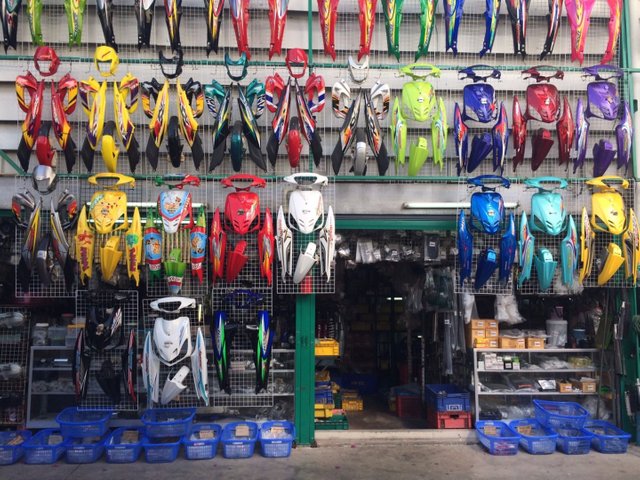Recognizing the Necessary Components of a Motorcycle: A Comprehensive Overview for Enthusiasts
For bike fanatics aiming to raise their riding experience and guarantee their bikes run smoothly, comprehending the crucial elements of a motorcycle is extremely important. Each aspect, from the engine's detailed functions to the important duty of the braking mechanisms, not just affects performance yet likewise safety and security and convenience. This overview will certainly go through the basic parts that every rider should be acquainted with, enabling notified options in both upkeep and potential upgrades. As we begin this exploration, one must ask: exactly how does each element interact to create the smooth adventure every enthusiast seeks?
Engine Components

The camshaft plays a critical duty in regulating the timing of the engine's valves, making sure the exact opening and closing needed for efficient fuel and air intake, as well as exhaust expulsion. This timing is essential to keeping optimum engine efficiency and effectiveness. In addition, the carburetor or gas injection system, depending on the motorcycle model, is in charge of mixing air with gas in the correct proportion for burning.
The cooling system, either air or liquid-based, works to maintain the engine's temperature within functional limits, avoiding overheating and ensuring durability - motocross gear nz. Each element, thoroughly designed and integrated, adds to the smooth procedure of the engine, defining the motorbike's power outcome and general efficiency
Transmission System
Important to the bike's capability, the transmission system guarantees reliable power transfer from the engine to the wheels. This system comprises several vital parts, consisting of the clutch, gearbox, and final drive, each playing a vital role in translating the engine's power into movement. The clutch, generally run by a hand lever, serves to engage and disengage the engine from the transmission, enabling smooth equipment adjustments and regulated velocity.
The transmission, often referred to as the transmission proper, contains a collection of equipments that riders can by hand change with to change the bike's rate and torque outcome. These gears are arranged in a series that allows the motorcycle to increase efficiently and maintain optimum engine efficiency throughout various rates. A lot of motorcycles use a consecutive gearbox, needing the motorcyclist to shift equipments in a fixed order.
Braking Systems
While comprehending the transmission system is key to utilizing a motorcycle's power, equally vital is the capability to control and stop that power effectively, which is where stopping mechanisms enter into play. Brakes are crucial for safety and efficiency, providing the cyclist with the required control to navigate various surfaces and conditions. Commonly, bikes feature 2 sorts of stopping systems: disc brakes and drum brakes.
Disc brakes are extra common in modern motorbikes due to their premium performance. They include a brake disc, caliper, and pads. When activated, the caliper presses the brake pads against the rotating disc, converting kinetic power right into heat, therefore slowing down the wheel. This system offers much better warmth dissipation, constant performance, and improved quiting power, especially in damp conditions.
Conversely, drum brakes, though less typical, are still found in some motorcycles. They work by pressing brake footwear against the inner surface of a drum connected to the wheel. While normally less efficient in warm dissipation and quiting power, drum brakes are less complex and much more economical.
Recognizing these stopping systems' subtleties permits riders to maintain their motorcycles correctly and value the design that makes certain efficient and risk-free quiting.
Suspension and Guiding
Suspension and steering systems are important parts that considerably influence a motorcycle's handling and ride comfort. The suspension system, containing forks at the front and shock absorbers at the rear, takes in roadway abnormalities, improving security and control. Front forks, inverted or usually telescopic, compress and rebound to alleviate impacts, while back shock absorbers keep tire contact with the road, essential for grip and safety.
Guiding, centered around the handlebars, biker protective jacket links the biker to the bike's directional control. The steering head bearings make sure smooth procedure, permitting precise maneuverability. Appropriate positioning and maintenance of these bearings are crucial for predictable steering reaction and minimizing rider tiredness.
The suspension's adjustability is one more important element; preload, damping, and rebound setups permit personalization to match different riding conditions and styles. This versatility is crucial for enhancing efficiency, whether navigating urban streets or tackling rugged routes. Technologies like electronic shock absorber provide real-time changes, enhancing ride high quality across varied terrains.

Electric Equipments
After ensuring a smooth and controlled experience through reliable suspension and steering systems, attention transforms to the electric systems, a crucial element of modern-day motorcycles. These systems play an important role not just in starting the engine yet also in powering different parts that improve the functionality and safety of the motorbike.
At the heart of a motorbike's electric system is the battery, which stores electrical power essential for starting the engine and powering auxiliary systems - mx gear nz. The alternator or generator, combined with the rectifier-regulator, makes certain the battery continues to be billed while the bike is in operation, converting power into electric power and keeping voltage degrees
The ignition system, one more critical part, is in charge of igniting the air-fuel combination in the engine's cylinders. Modern motorbikes often make use of a digital ignition system, offering better efficiency and dependability contrasted to typical systems.
Lighting systems, consisting of headlights, tail lights, and indications, are also essential, guaranteeing presence and safety for the biker. Added digital components such as sensors, control devices, and presents add to advanced features like fuel injection monitoring, anti-lock braking systems (ABS), and digital dashboards, additionally boosting the riding experience.
Final Thought
An extensive understanding of a motorbike's vital components, including the engine, transmission riding jacket sale system, braking mechanisms, suspension, steering, and electrical systems, is vital for enthusiasts aiming to optimize security, performance, and convenience. Proficiency of these elements permits for informed decisions relating to upkeep and upgrades, inevitably boosting the riding experience. By integrating this understanding, bikers can guarantee their bikes operate at peak efficiency and dependability, thereby making the most of both satisfaction and long life of their automobiles.
For motorcycle lovers looking to boost their riding experience and ensure their bikes run efficiently, recognizing the vital parts of a motorcycle is extremely important.Integral to the motorcycle's performance, the transmission system makes sure effective power transfer from the engine to the wheels.While site here comprehending the transmission system is essential to using a motorcycle's power, similarly important is the ability to manage and stop that power successfully, which is where stopping systems come into play. Generally, bikes include 2 types of braking systems: disc brakes and drum brakes.
A thorough comprehension of a motorcycle's important components, including the engine, transmission system, braking systems, suspension, steering, and electric systems, is indispensable for lovers aiming to optimize safety, convenience, and efficiency.